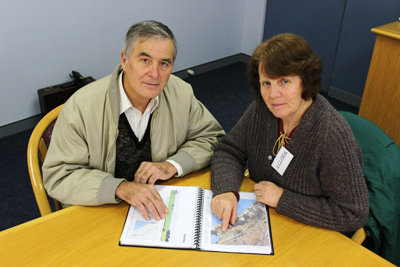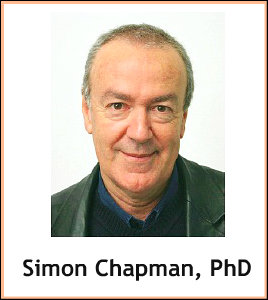Wind turbine “hosts” get Wind Turbine Syndrome (Australia)
Apr 3, 2013

·
Editor’s note: The couple, above, leased their land to a wind company. They subsequently became ill with Wind Turbine Syndrome (WTS). They were recently interviewed by Australia’s radio talk-show host, Steve Price. Joining them in the interview is the CEO of the Waubra Foundation, Dr. Sarah Laurie.
Click here for the interview.

Professor Simon Chapman, a sociologist in the School of Public Health at the Univ. of Sydney (Australia), insists WTS is contracted by the power of suggestion. (No, I’m not kidding!) It turns out this is news to Mr. & Mrs. Mortimer, who think Mr. Chapman’s thesis is—dare I say it?—horseshit.

Comment by Frank Haggerty on 04/03/2013 at 9:47 pm
Ask the people in Falmouth, Massachusetts about the daily wind turbine torture they fear every time the wind blows.
Every time another commercial megawatt turbine goes up in Massachusetts, another 50 families get sick!
Has wind turbine torture really been turned into morally neutral entertainment for the proponents of commercial wind in Falmouth? At the end of World War II, citizens who lived near prison camps were asked why they did nothing about the torture. They replied, “We didn’t know what was going on.” The next question for which they had no reply was, “Didn’t you notice millions of your neighbors missing?”
The Town Of Falmouth, Massachusetts made a mistake building commercial megawatt turbines too close to residential homes. The town will now vote to either take down the turbines or take up to 99 homes by eminent domain.
STOP THE TORTURE!
Comment by Andreas Marciniak on 04/04/2013 at 2:32 am
Hi Calvin, you know that I’m from Waterloo, South Australia. What I don’t understand with all the information out there! Why are we still talking about setbacks of 2 km? We know from the Waterloo turbines that you can feel their effects as far away as 10 km. We know they produce very little power at a very high cost to consumers and the cost to the environment is extreme.
Is everyone sleeping?
As for Professor Simon Chapman, I wonder: If he would put as much effort into wind turbines as he did with the tobacco industry, he might find they both lied about the effects their products have on people?
Comment by Jackie on 04/05/2013 at 1:53 am
My heart goes out to all WTS victims. I fear that very soon I will live the same tragic experiment.
Recently, a IWT project leader indicated that, if it was a problem then why aren’t our hospitals full of these so called sick people? Our anger & discussions led to a “lightbulb” moment. Fortunately, we have a healthcare system in Canada. I urge all victims to go to your local hospital, to get a good night’s sleep. The nurses might wake you up occasionally to take your temperature, but this would be better than spending your hard earned tax dollars on a hotel room.
If they won’t do health studies, then a regular trip to the hospital, several nights in a row, may make them pay attention.
Comment by Simon on 04/13/2013 at 11:37 am
My wife and I—like so many others—got our Wind Turbine Syndrome (WTS) not from a wind turbine installation but from inaudible ILFN (infrasound/low frequency noise) from the fans of a heat exchanger unit on a neighboring lot. After 3 months of exposure, I checked into the Emergency Room of our hospital. So yes, people with WTS / SBS (Sick Building Syndrome) do end up in hospitals . . .
A few months later we got the authorities to conduct an analysis of the ILFN in our house. The result: A peak at 18Hz, at levels just below the threshold of hearing. When presenting the facts to the medical faculty of a major university in our country (in Central Europe), we were surprised to learn that the effects of ILFN were known to them since 1985, when they did a survey on the effects of low-level infrasound from heating/ventilation systems on office workers.
In that report, they clearly define the symptoms as a result of the effects that ILFN has on the central nervous system. The possibility of a “nocebo” effect is actually discussed as a potential explanation. But with a much better-fitting model available, the “Nocebo Theory” was quickly dismissed by the research team.
So, Professor Simon Chapman’s hogwash is only a mere 28 years behind what proper scientists in the field of occupational medicine know today. Some early literature describing the effects of ILFN on the vestibular system even dates back to 1969 (Tempest) and even earlier.
Now, my background is in human factors / occupational medicine and not sociology (Prof. Chapman’s field). Before I would even as much as think of issuing a statement about some effect that might fall in the territory of sociology, I would first do some basic homework on the issue. The benefit of this approach is 3-fold:
a) it follows the rules of common sense
b) that’s how scientists work
c) it minimizes the risk of publicly making an ass of myself
Apparently, this is not how know-it-all Chapman approaches things. Therefore, one should seriously question his ability to work according to scientific standards as well as his ability to apply common sense. And why anyone would want the world to see their cognitive and/or professional shortcomings, I have no clue.
Usually, seemingly irrational behaviour can make a lot of sense when money is involved—but that’s just speculation.